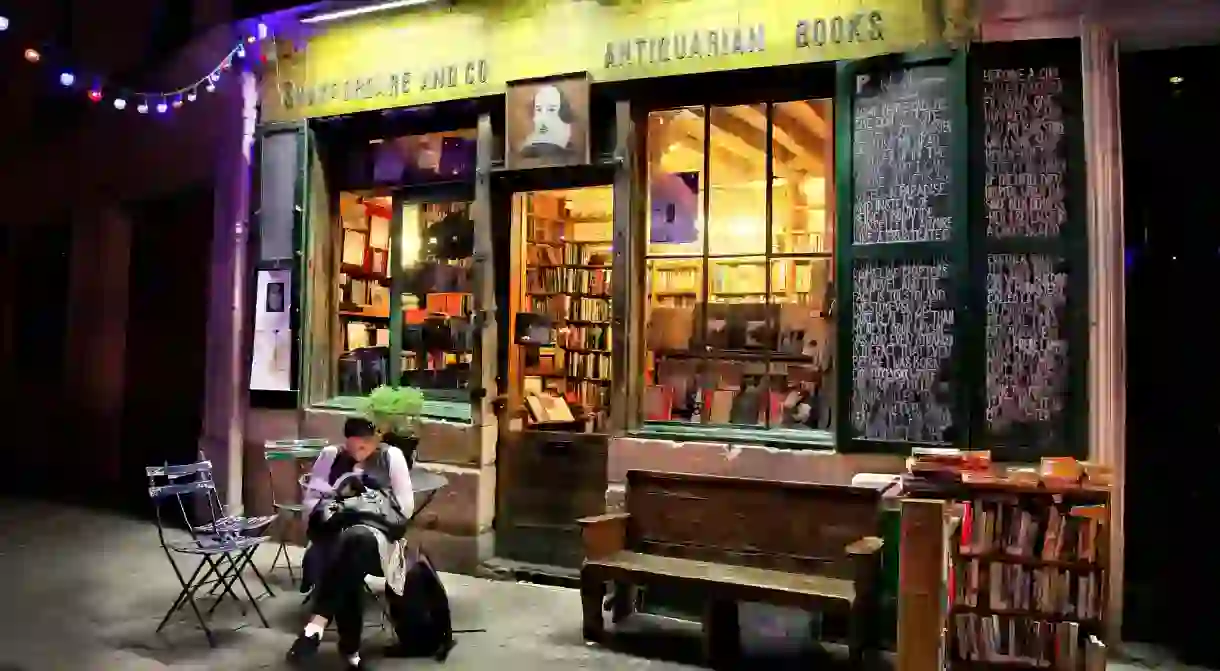20 Pictures That Prove Paris is a Book Lover's Paradise

Ever wanted to pack in the day job, move to an attic in Paris, and finally write the novel that’s been rattling around in your head since college? Or even simply to walk in the footsteps of those who’ve taken that leap across the Atlantic, the Channel or whichever bodies of water lie between you and here? Well, here’s a taste of why that might just be the thing to do.

Paris wouldn’t be Paris without its Seine-side bouquinistes. There are 240 of these second-hand booksellers operating along the riverfront (a UNESCO World Heritage Site), and their 900 iconic green boxes contain over 300,000 old books, as well as journals, prints and stamps.

No matter where you are in the city, you’re liable to find a densely packed used bookstore nearby. At the stalls outside the Boulinier stores on the Boulevard Saint-Michel and Boulevard de Bonne Nouvelle, you can pick up a paperback for as little as 20 cents.

Despite France having approximately one-fifth of the population of the United States, it has slightly more independent bookstores. And the local industry is thriving, with a 5% increase in the number of traders recorded between 2009 and 2013.

With all these incredible independent and second-hand stores to discover, you might want to alert your next of kin about any planned shopping expeditions, in case you get lost among the thousands of bookshelves. Bright clothing and a trail of breadcrumbs are also advised.

Paris also has some of the oldest and, without wanting to sound biased, most beautiful libraries in Europe. The oldest of the 57 public libraries is the Bibliothèque Mazarine, and the capital’s total lendable collection amounts to 3.5 million documents.

The modern buildings of the Bibliothèque nationale de France (BnF) are a standing tribute to the city’s love of literature and its status as a haven for book lovers. The four book-shaped towers were roundly mocked by architecture critics but they do have their own kind of charm.

The public libraries are free to use and open to everybody. If you want to take a book home with you (temporarily, of course), all you need to do is enroll yourself for a one-year membership using a valid form of ID like a passport or driving license.

There are hundreds of novels, short stories and memoirs set in Paris, the locations of which, if not explicitly given, the careful reader can deduce without too much trouble. One setting that everyone’s surely familiar with is that of Victor Hugo‘s The Hunchback of Notre-Dame.

The city’s cafés are synonymous with the French literary scene. Voltaire downed dozens of coffees every day at the Café Procope, and Les Deux Magots on the Boulevard Saint-Germain was the place to be for native writers and their expat friends during the 1950s.

In Paris, a booze cruise is undoubtedly a legitimate literary outing. During the Roaring Twenties, Hemingway, the Fitzgeralds, and their crew did some serious drinking in the bars of the Left Bank and in Harry’s New York Bar on the other side of the river.

While many literary stars only stayed in Paris for a while (usually until they had found success), others made it their home. In the cemeteries of Montparnasse and Père Lachaise, you can lay flowers or plant a kiss on the tombs of Sartre, de Beauvoir, Wilde and others.

Paris’s gardens were made for readers. There are benches if you don’t mind having neighbors while you get stuck into a novel, but there are also individual (sometimes reclined) chairs that you can move into a secluded spot. Or, like this chap above, the sunniest one you can find.

Shakespeare and Company is much more than a bookshop; it’s a literary institution. The store’s first incarnation, opened by Sylvia Beach on November 19, 1919, was a meeting place for the talented new writers of the era like Ezra Pound, James Joyce and Ford Madox Ford.

The store that you can visit today was opened by George Whitman in 1951 and adopted the name of Beach’s shop on Shakespeare’s 400th anniversary in 1964. An estimated 30,000 ‘Tumbleweeds‘ have slept between its bookshelves in exchange for a few hours of work.

The Marais is full of excellent places to curl up with a good book. One of the best is the Used Book Café at the Merci concept store. There are over 10,000 volumes to work through on its shelves and a great selection of cakes to help you on your way at its counter.

For those of sturdier stock – those who have no need for soft seating, sweet cakes, and the murmur of café noise to get on with some serious reading – there are limitless steps, ledges, nooks and crannies in Paris in which to park it with a book.

A number of writers’ residences have been transformed into, or partially transported to, museums in Paris. Two of the best are the Maison de Victor Hugo in the Marais and the Musée de la Vie Romantique in Montmartre, the former home of George Sand.

The city’s museums also regularly mount literary exhibitions. In 2016, the Centre Pompidou had a five-month show focusing on the work of the Beat Generation, and the Oscar Wilde exhibition at the Petit Palais will be wrapping up at the end of January 2017.

To be sure, Parisians don’t need their cafés to be exceptionally historic or trendy in order to read in them. No, just about anywhere will do, so long as there’s coffee on the menuu and interesting enough people to steal a glance at between chapters.

This guy is the ultimate proof that Paris is a city of and for book lovers. So absorbed was he by the book he’s reading, that he appears to fallen off his bike mid-page without even noticing. What a champion!













